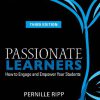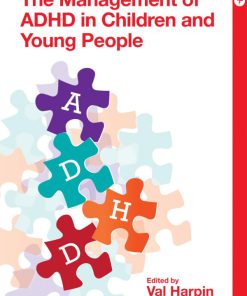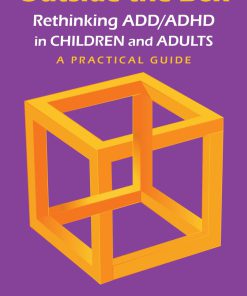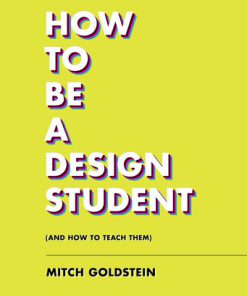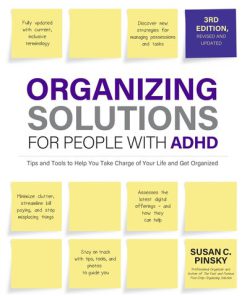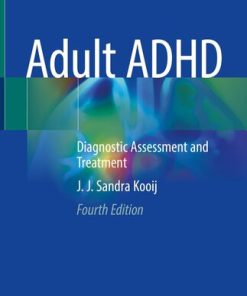How to Reach and Teach Children and Teens with ADD ADHD 3rd Edition by Sandra F Rief 9781118937792 1118937791
$50.00 Original price was: $50.00.$25.00Current price is: $25.00.
How to Reach and Teach Children and Teens with ADD ADHD 3rd Edition Sandra F Rief – Ebook PDF Instant Download/Delivery, IBSN: 9781118937792, 1118937791

Product details:
- ISBN 10: 1118937791
- ISBN 13: 9781118937792
- Author: Sandra F Rief
How to Reach and Teach Children and Teens with ADD/ADHD
- Prevent behavioral problems in the classroom and other school settings
- Increase students’ on-task behavior, work production, and academic performance
- Effectively manage challenging behaviors related to ADHD
- Improve executive function-related skills (organization, memory, time management)
- Apply specific research-based supports and interventions to enable school success
- Communicate and collaborate effectively with parents, physicians, and agencies
Table contents:
Part 1: Key Information for Understanding and Managing ADHD
Section 1.1: Understanding ADHD
Clarifying Terms and Labels
Descriptions and Definitions
Signs and Symptoms
Three Presentations of ADHD
Statistics and Risk Factors
ADHD and Coexisting Disorders
ADHD Look-Alikes
What Is Currently Known about ADHD
ADHD Brain Differences
Causes of ADHD
Girls with ADHD
Positive Traits and Strengths
ADHD and the Impact on the Family
Section 1.2: ADHD and Executive Function Impairment
Definitions of Executive Function (EF)
EF Analogies and Metaphors
EF Components
EF Dysfunction in ADHD
Models Explaining Executive Function Impairment in ADHD
Other Information about Executive Functions
What Parents and Teachers Should Keep in Mind
Section 1.3: Making the Diagnosis: A Comprehensive Evaluation for ADHD
Clinical Evaluation for ADHD
DSM-5 Criteria
Components of a Comprehensive Evaluation for ADHD
Pursuing an ADHD Evaluation
What Teachers and Other School Professionals Need to Know
Section 1.4: Multimodal Treatment for ADHD
Multimodal Intervention
Additional Points to Keep in Mind
Caution about Alternative Treatments
Section 1.5: Medication Treatment and Management
Stimulant Medications in the Treatment of ADHD
Nonstimulant ADHD Medications
Other Medications
Additional Information
If a Child or Teen Is Taking Medication: Advice for School Staff and Parents
Section 1.6: Behavioral Therapy for Managing ADHD
General Principles of Behavior Modification
Home-Based Behavioral Treatment
School-Based Behavioral Treatment
Child-Based Behavioral Treatment
Section 1.7: Critical Factors in the Success of Students with ADHD
Section 1.8: ADHD in Preschool and Kindergarten
Developmental Signs and Symptoms in Young Children
Red Flags for Possible Learning Disabilities
What the Research Shows
Evaluation, Diagnosis, and Intervention
More Strategies and Tips for Parents
Kindergarten Academic Skills and Expectations
Research-Supported Intervention Programs for Preschool and Kindergarten
Strategies and Tips for Preschool and Kindergarten Teachers
Strategies and Tips for Early Childhood Teachers*
Section 1.9: ADHD in Middle School and High School
For All Kids This Age
ADHD-Related Challenges and Needs
Addressing Coexisting Disorders
School Supports
Aiding the Transition to Middle or High School
Transition Plans
Warning Signs (Red Flags) in Middle School and High School
Warning Signs of Learning Disabilities in Teens
Understanding Their ADHD and Self-Advocacy
The Value of Mentorship
Part 1 References
Part 1 Additional Sources and Resources
Part 2: Managing the Challenge of ADHD Behaviors
Section 2.1: Proactive Classroom Management
Classroom Management Tips
Environmental Supports and Accommodations in the Classroom
Common Triggers or Antecedents to Misbehavior
Address Student Misbehavior
Section 2.2: Preventing Behavior Problems during Transitions and Less Structured Times
Section 2.3: Class (Group) Behavior Management and Incentive Systems
Positive-Only Group Reinforcement Systems
What to Do about Students Whose Behavior Interferes with Group Success
Points to Keep in Mind
Section 2.4: Individualized Behavior Supports and Interventions
Target Behaviors
Individualized Interventions
Functional Behavioral Assessments (FBAs) and Behavioral Intervention Plans (BIPs)
Section 2.5: Strategies to Increase Listening, Following Directions, and Compliance
Strategies and Tips for Teachers
Increasing Compliance
Oppositional Defiant Disorder and ADHD
Section 2.6: Managing Challenging Behavior: Strategies for Teachers and Parents
Strategies for Emotional Regulation and Control
Dealing with Argumentative and Oppositional Behavior
Section 2.7: School-Based Social Skills Interventions
ADHD-Related Difficulties
Skill Deficits versus Performance Deficits
The Impact on Children and Families
Classroom Interventions
Schoolwide Programs and Interventions
Goal-Setting Tips
Social Skill Lesson Plan
Report Form: Social Skills
Part 2 References
Part 2 Additional Sources and Resources
Part 3: Instructional, Learning, and Executive Function Strategies
Section 3.1: Attention!! Strategies for Engaging, Maintaining, and Regulating Students’ Attention
Getting and Focusing Students’ Attention
Maintaining Students’ Attention through Active Participation
Keeping Students On-Task During Seatwork
Teacher Tips for Helping Inattentive, Distractible Students
Self-Monitoring Attention (Self-Regulatory Techniques)
Section 3.2: Research-Based Instructional Approaches and Interventions
Universal Design for Learning (UDL)
Differentiated Instruction
Response to Intervention (RTI)
Peer-Mediated Instruction and Intervention
Blended Learning
Designing Interventions for Struggling Learners: Key Instructional Components
Section 3.3: Organization and Time Management
What Teachers Can Do to Help with Organization
What Teachers Can Do to Help with Time Management
Section 3.4: The Homework Challenge: Strategies and Tips for Parents and Teachers
Homework Tips for Parents
Homework Tips for Teachers
Section 3.5: Learning Strategies and Study Skills
What Are Learning Strategies?
Metacognition and Metacognitive Strategies
Cognitive Learning Strategies
More Learning and Study Strategies
Section 3.6: Memory Strategies and Supports
Definitions and Descriptions of Working Memory
Working Memory Deficits and ADHD
Difficulties Associated with Poor Working Memory
Supports and Accommodations for Memory Weaknesses
Cognitive Working Memory Training (CWMT) Programs
Mnemonics
Music and Rhyme
Other Memory Strategies and Tips
Multimodal and Memory Techniques for Learning Multiplication Tables
Memory Techniques for Other Hard-to-Remember Information
Part 3 References
Part 3 Additional Sources and Resources
Part 4: Strategies and Supports for Reading, Writing, and Math
Section 4.1: Common Reading and Writing Difficulties
The Reading Process: What Good Readers Do
Coexisting Learning Disabilities
Common Reading Errors and Weaknesses in Students with ADHD
Steps of the Writing Process and Potential Problems
Why Writing Is a Struggle
Section 4.2: Decoding, Fluency, and Vocabulary
Word Recognition and Decoding
Fluency
Section 4.3: Reading Comprehension
Strategies throughout the Reading Process
The Importance of Teacher Modeling of Strategic Reading
Graphic Organizers
More Key Comprehension Strategies
Other Reading Comprehension Strategies
Classroom Book Clubs
Section 4.4: Writing: Strategies, Supports, and Accommodations
Prewriting, Planning, and Organizing
Strategies for Building Skills in Written Expression
Strategies for Revising and Editing
Mnemonic Proofreading Strategies
Other Tips for Teachers
Strategies to Bypass and Accommodate Writing Difficulties
Section 4.5: Spelling and Handwriting
Helping Children with Spelling Difficulties
Improving Handwriting and Legibility of Written Work
Section 4.6: Mathematics
Math Difficulties Associated with ADHD and Learning Disabilities
Mathematics: Standards and Student Expectations
Mathematics Instruction
More Math Strategies, Supports, and Accommodations
Connecting Math to Writing and Literature
Part 4 References
Part 4 Additional Sources and Resources
Part 5: Personal Stories and Case Studies
Section 5.1: A Parent’s Story . . . What Every Teacher, Clinician, and Parent of a Child with ADHD Needs to Hear
Vincent (Seventeen Years Old, High School Senior)
Everything Ripples: The Education of Vincent and Victoria
Notes on Section 5.1
Section 5.2: Student Case Studies and Interventions
Chloe (Seven Years Old, First Grade)
Student Profile
Current Performance Levels
Desired Outcomes for Chloe
Intervention Plan
Teaming with Parents
Anne (Eleven Years Old, Sixth Grade)
Student Profile
Follow-up (Reported Spring Trimester of Sixth-Grade School Year, Provided by Mrs. Shorter)
Follow-up (Tenth-Grade School Year)
Part 5 References
Part 6: Collaborative Efforts and School Responsibilities in Helping Students with ADHD
Section 6.1: Teaming for Success: Communication, Collaboration, and Mutual Support
The Necessity of a Team Approach
The Parents’ Role in the Collaborative Team Process
The Educators’ Role in the Collaborative Team Process
The Clinicians’ Role in the Collaborative Team Process
Cultural Sensitivity in Communication with Parents
Section 6.2: The Role of the School’s Multidisciplinary Team
The Student Support Team (SST) Process
Multi-Tier System of Supports (MTSS)
If You Suspect a Student Has ADHD: Recommendations for Teachers and Other School Personnel
School-Based Assessment for ADHD
Section 6.3: School Documentation and Communication with Medical Providers and Others
Communication with Physicians
Communication between Schools
Teacher Documentation
Section 6.4: Federal Laws and Educational Rights of Students with ADHD
Individuals with Disabilities Education Act (IDEA)
Section 504 of the Rehabilitation Act of 1973
Americans with Disabilities Act Amendments Act of 2008 (ADAAA)
Which Is More Advantageous for Students with ADHD: An IEP or a 504 Plan?
Disciplining Students with Disabilities under IDEA 2004
Part 6 References
Part 6 Additional Sources and Resources
People also search:
how to reach and teach children
how to reach and teach children with challenging behavior pdf
how to teach a child to learn
how do you teach family to preschoolers
how to teach a child to walk
You may also like…
Biography & Autobiography - Film
Suzuki the man and his dream to teach the children of the world 1st Edition Eri Hotta
Relationships & Lifestyle - Families & Parents
The Management of ADHD in Children and Young People 1st Edition Val Harpin
Arts - Study & Teaching
How to Be a Design Student and How to Teach Them Mitch Goldstein
Housekeeping & Leisure - Interior Design & Decoration
Politics & Philosophy - Politics
How Civil Wars Start: And How to Stop Them Barbara F. Walter


